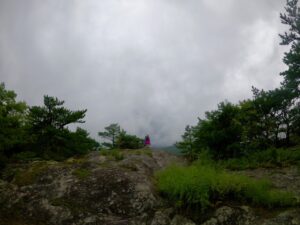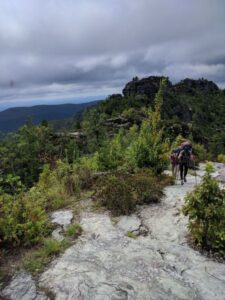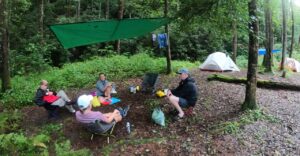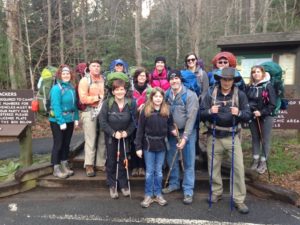We had just crawled into our tents Friday night when the rain started: a gentle patter at first, the kind known for lulling you to sleep. Then it got down to business.
I drifted off to sleep realizing that the weekend of cavorting in the pools and cascades of Wilson Creek that we had planned might not come to pass. We’d been waiting weeks, in 90-degree-plus weather, for the chance to jump into these chill mountain pools, then sun off on the adjoining granite slabs, and repeat. Oh well, I thought, good thing we have a Plan B.
It’s not so much the unexpected that torpedoes an outing, it’s the lack of a backup plan. As Yvon Chouinard put it, “For me, when everything goes wrong — that’s when adventure starts.”
We may take issue with the word “wrong” (“askew”?) but I’m onboard with the overall sentiment. When things don’t go according to plan, go to Plan B.
Every morning I like to hike 3 miles before heading into the office. I have several standard routes that fit the bill, and I use this 45 minutes of meandering to mull as well: to think about the day ahead, to plan, to get organized. Every hike is different — cloudy one day, sunny the next, 71 degrees one morning 61 the next — but I like these hikes because they are predictable and don’t require much attention. While they are outdoors and generally in scenic settings, they do not constitute adventure. They are outings.
True adventure

True adventure, by Patagonia founder Chouinard’s definition, is hard to come by. Take a hike at your local State Park, for instance. North Carolina is blessed with 41 pretty darn special state parks, recreation areas and natural areas. But with few exceptions, it is hard to have a Chouinardian adventure in one of these playgrounds. The trails are well maintained, you’re rarely beyond sight of a blaze, there are restrooms. Sure, you might get caught in a freak snowstorm atop Grandfather Mountain, or momentarily misdirected in the rainforest of Gorges State Park. But by and large, these are safe, chaperoned excursions into the woods. The basic trail map available at most trailhead kiosks is all you need to safely navigate. Adventure? Mmm, no.
When Plan A goes askew

So what does constitute true adventure, when Plan A goes askew?
Let’s say you’re leading a backpack trip into the Linville Gorge Wilderness and a storm rolls in. It’s raining pretty good, causing everyone to look down, to keep their eyes on the rivery trail. The lead hiker misses a fork and takes the wrong tine, a tine that leads into oblivion. You eventually catch that mistake, rejoin the main trail, then encounter an area where the trail is indistinct (this is a Designated Wilderness, remember, where signs and blazes are frowned upon).
As an electrical storm joins the rain, you find the trail but somehow end up taking it the wrong way — in the direction you came from. But because it’s 10:30 at night, dark and raining, you don’t realize that. That is, until you realize you’re back to where your initial fork-inspired adventure began. It’s 11:30 by now, you say to heck with it and advise everyone to find a spot to pitch camp. You do likewise, then set out to find water, because everyone now, ironically, is low on water. Your adventure continues for several more hours as you become even more disoriented and end up sleeping under a rock (a rock that you discover in dawn’s early light is maybe a half mile from the parking lot you started from 18 hours earlier).
Enter Plan B

Our resulting Plan B? The next day we hiked to our intended destination for the day before and pitched camp. Our plan to do a loop of the gorge was scuttled, but likely would have been anyway: the heavy rains made a necessary river crossing too dangerous to try. We eventually dried out and spent the rest of the day sunning on an outcrop overlooking the gorge. Not the trip we envisioned, but pretty darn swell all the same. And an adventure we’ll be sharing for years.
Friday night at Wilson Creek I had little trouble sleeping because I already had a good Plan B in mind. While 49,000-acre Wilson Creek is best known in summer for its refreshing pools, it also has some mature forest that makes for great rainy day hiking. We ended up doing the mellow North Harper Creek Trail under thick, rain-absorbing canopy, then the Lost Cove Cliffs Trail, which lead to an eerily cloud-shrouded overlook. We didn’t get the spectacular view we sought, but it was pretty cool being in the clouds as they formed and parted. (We would get our view the next day, when Part II of Plan B, took us, under clearing skies, to Big Lost Cove Cliffs, pictured above.)
We always hope that our trips go as planned. As a result we generally don’t form a Plan B before heading out. Which is why Plan Bs typically are formed on the fly. Which shouldn’t be a problem if you’ve done your homework during your original trip planning. In determining the route you’ll take, you should also be evaluating nearby options. Take a map — yes, it’s old school, but it helps you see the bigger geographic picture — and see what’s around you. If you’ve chosen a particularly challenging route, then get injured or discover you aren’t in shape, are there less challenging options nearby? Check for trails where the topo lines aren’t as tight, then look for trail reviews on alltrails.com, hikingproject.com, or your favorite trail app. Or maybe you come down with the sniffles and would rather bask in the sun than labor up a mountain. See if there are campsites near (but not too near) trailheads that are also near a nice feature. (At Wilson Creek, there are several good — and little used — campsites adjoining Big Lost Cove Cliffs, just a 1.7-mile hike in.)
It may take some extra digging to spot these options, but isn’t planning a trip part of the fun? Besides, if Plan A falls through, your outing isn’t over. In fact, there’s a good chance you’re in for a true adventure.
* * *
Adventures in backpacking

One of the many things we love about backpacking — of strapping everything you need to your back and heading into the backcountry — is that while you always want to have a Plan A, there’s a good likelihood you’ll have to resort to Plan B. Because of the planning and forethought required to backpack, you’ll likely be better prepared to conjure up a Plan B. Provided, that is, you learn the ins and outs of backpacking before hitting the trail.
That’s the goal of our GetBackpacking! Intro to Backpacking program, designed to make you a competent, confident backpacker in three sessions.
- Session 1: Getting to know you, getting to know your gear. In a Zoom intro meeting we learn about each other, about backpacking and how the class will unfold, and about gear.
- Session 2: In full pack, we hike hike a couple miles to a campsite, set up camp, cook a meal. You get a sense of how to properly pack a pack, how to carry weight, how to assess a campsite, how to pitch camp, how to eat on the trail (well, by the way).
- Session 3: A three-day, two-night graduation trip to South Mountains State Park.
We have two sessions scheduled for the fall. Click the appropriate link for more information and to sign up:
- Triangle area, with in-field training at Eno River State Park on Oct. 3 and the graduation trip Oct. 23-25. Details here.
- Charlotte area, with in-field training at Morrow Mountain State Park on Oct. 3 and the graduation trip Oct. 16-18. Details here.
